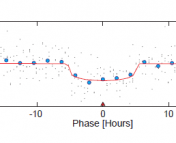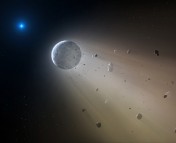Title: Exoplanet Transit Variability: Bow Shocks and Winds Around HD 189733b
Authors: J. Llama, A. A. Vidotto, M. Jardine, K. Wood, R. Fares, T. I. Gombosi
First Author’s Institution: University of St. Andrews
Transit observations of an exoplanet can give us a lot of information about the planet, such as its radius, orbital period, and even the composition of its atmosphere (when combined with spectroscopy). But now new modeling indicates that we can even study the magnetic field of the host star using transits!
A transit occurs when an exoplanet passes between us and the host star. The planet blocks a small amount of light from the star, and we see a dip in the light collected by our telescopes. In some cases, the transit seems to start too early, as if something were orbiting the star just ahead of the planet, and blocking some of the light from the star. This “something” could be a bow shock, a curved shock wave created where the planet’s magnetic field interacts with the stellar wind of the star. See Fig. 1 for an illustration of how a bow shock can create an asymmetric transit light curve.

Fig 1: Model transit light curve of an exoplanet with a bow shock (lower pane, solid line). The dashed line shows the light curve without a bow shock. The upper row of images show the model planet (solid circle) and bow shock (grey curve) as they pass in front of the star. Note that since the bow shock begins to cross the star before the planet, the “dip” in the transit light curve starts earlier.
The amount of light blocked by the bow shock will change as the planet moves through a variable stellar wind. By studying the transit light curves, we could map out the different regions of stellar wind. The authors previously investigated the relationship between stellar wind and transit light curves in the WASP-12 system and presented their results at the IAU Planet Formation Symposium. In this paper, they improve on their model and apply it to a different planetary system, HD 189733.
The authors start with maps of the magnetic field of the star, based on data collected by the Canada-France-Hawaii telescope in June 2007 and July 2008. They use this maps to create a model of the stellar winds around the star at each time. Next, they model the bow shock created as the planet passes through the stellar wind. Finally, they simulate the light curves that would result from the planet and bow shock orbiting in front of the star. The angle at which the stellar wind hits the planet can change the strength of the bow shock, so the authors ran the models multiple times, trying the strongest and weakest possible bow shocks, as well as an intermediate bow shock. The results are shown in Fig. 2.

Fig 2: Top row: Map of the total wind pressure around HD 189733 based on data taken in June 2007 (left) and July 2008 (right). Middle row: Map of the wind density around HD 189733 at the two epochs. Bottom row: Model transit light curves at each epoch. The dashed lines indicate the models without a bow shock. The three solid lines in each plot show the light curves for the strongest, weakest, and one intermediate bow shock.
There were no transit observations taken at the same time as the magnetic field observations of HD 189733, so the authors weren’t trying to reproduce a set of observed light curves. Instead, they wanted to demonstrate that their model could use magnetic field maps to simulate asymmetric light curves. This model can easily be adapted to other systems. The next step will be to take observations of both a star’s magnetic field and the exoplanet transit taken at the same time, and test whether the model can work in reverse: can the transit light curves be used to generate a partial map of the magnetic field? This would make it possible for observers to study the magnetic field of a star using only the exoplanet transit data!





Interesting.. has anyone tried modelling the effect of a large moon (or moons) on transit curves ?
Great question! Yes, there has been a lot of interest in using transit light curves to find exomoons. Nick wrote a great astrobite on the first Kepler search for exomoons around habitable exoplanets here: http://astrobites.org/2013/06/20/in-search-of-the-first-habitable-exomoon/.
Great article Erika, you’ve captured the key points we tried to make in the paper perfectly!
Glad you found the work interesting, fingers crossed there will be more to follow…
exoplanets and magnetic fields – bearing on SETI
We have powerful – megawatt – radio transmitters because the earth has an ionosphere. If earth had no magnetic field there would be no ‘beyond the horizon’ radio transmissions. Virtually all radio would be carried by kilowatt power transmitters,
Should SETI turn its attentions to planets with magnetic fields at least as strong as earth’s?
Further, difficult though it is, should SETI retune its activities to those parts of the spectrum where, on the basis of convergent evolution, the earth is brightest – such as megawatt pulse transmissions from radar like equipments and in the same range of frequencies as the laws of physics demand that we use for reasons of atmospheric transparency?